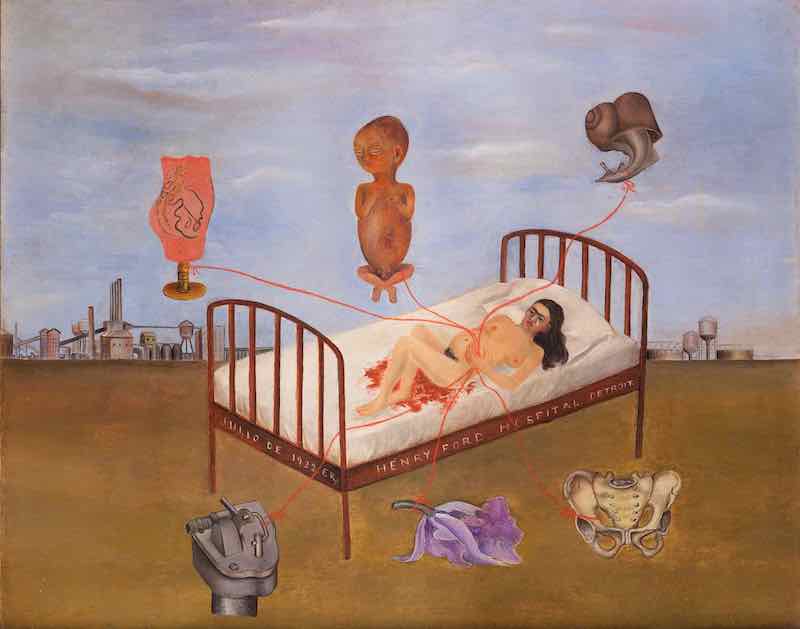
El 4 de julio de 1932, Frida sufrió un aborto en Detroit, después de estar bajo la supervisión de sus médicos, quienes le dijeron que si pasaba largas temporadas en cama, en total reposo, podría llevar a buen término su embarazo. Sin embargo, su cuerpo no lo resistió y finalmente fue llevada al Hospital Henry Ford, donde culminó el proceso de aborto que había comenzado en su casa.
Días después, en medio de una gran depresión, Frida pidió que le llevaran el feto de su hijo para poder pintarlo. Esto no sucedió y tuvo que conformarse con algunas ilustraciones que le fueron proporcionadas por Diego y los médicos, con las que comenzó a realizar dibujos para esta obra, que lleva el nombre del hospital donde fue atendida.
El cuadro muestra su pequeña y desvalida figura, en medio de una cama enorme, ensangrentada; su vientre se encuentra todavía abultado y a su alrededor aparecen seis elementos sujetos con listones rojos, cual si fueran cordones umbilicales, sostenidos por su mano. A la derecha, sobre la cabecera de la cama, flota un caracol -según declaraciones de Frida es un símbolo de la lentitud del aborto-; en el centro, un feto masculino, el hijo que deseaba; a la izquierda, una maqueta médica color rosa, que muestra la zona de la pelvis, aludiendo a las fracturas de su columna; abajo, a la izquierda, una maquina; en el centro, la orquídea que le regaló Diego y, por último, el hueso pélvico. Las lágrimas brotan de sus ojos, mientras que en el horizonte aparece una vista de la Ford Motor Company, en la ciudad industrial de Detroit, donde Rivera trabajaba en sus murales.
“Aborté en un abrir y cerrar de ojos», le escribió al doctor Leo Eloesser.Hospital Henry Ford es la primera pintura en la que Frida utilizó como soporte una hoja de metal, a la manera de los retablos o ex votos mexicanos.
On the 4th of July of 1932 Frida suffered a miscarriage in Detroit, even after being under the supervision of her doctors, who had recommended long periods of complete bed rest to bring her pregnancy to term. Her body, however, was unable to resist and she was finally taken to the Henry Ford Hospital, where the abortion process, that had begun at home, finally concluded.
Some days later, in a state of deep depression, Frida asked to be brought the fetus of her child so that she could paint it. She was not granted her wish, having to settle with some illustrations provided by Diego and her doctors, with which she began to create this work, named after the hospital where she was cared.
The painting shows her small, helpless body bleeding on an enormous bed. Her belly is still swollen and six different elements appear around her, attached to her hand by red ribbons, as though they were umbilical cords. On the right, above the head of the bed, floats a snail— according to Frida, a symbol of the slowness of the miscarriage. In the middle there is a male fetus of the wished-for son, and to the left, a pink orthopedic cast of the pelvic zone that refers to the fractures of Frida’s spinal column. Below, on the left, there is a machine; in the middle, an orchid gifted by Diego; and finally, on the right, a pelvic bone. Tears pour from Frida’s eyes. On the horizon, there is a view of the Ford Motor Company in the industrial city of Detroit, where Rivera was painting some murals.
“I had an abortion in the blink of an eye,” Frida wrote to Dr. Leo Eloesser.Henry Ford Hospital is the first painting for which Frida used a metal sheet as a support, in the tradition of Mexican ex-votos, or votive tablets.
Material documental propiedad del Museo Dolores Olmedo, realizado por Josefina García.